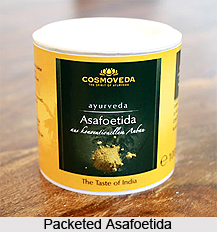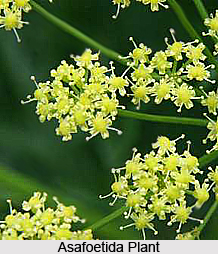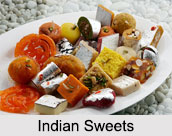 Asafoetida is the dried latex exuded from the tap root of several species of Ferula perennial herbs growing 3.3 to 4.9 ft tall. They are part of the celery family, Umbelliferae. Asafoetida is thought to be in the same genus as silphium, a North African plant now believed to be extinct. The species are native to the deserts of Iran and mountains of Afghanistan. Here, substantial amounts are grown. The common name for the plant in Iran and Afghanistan is "badian", meaning: "that of gas or wind". According to the latest amendment of Food Adulteration Act, 1954 amended up to date, the definition for Hing or Hingra and Bandhani Hing is:
Asafoetida is the dried latex exuded from the tap root of several species of Ferula perennial herbs growing 3.3 to 4.9 ft tall. They are part of the celery family, Umbelliferae. Asafoetida is thought to be in the same genus as silphium, a North African plant now believed to be extinct. The species are native to the deserts of Iran and mountains of Afghanistan. Here, substantial amounts are grown. The common name for the plant in Iran and Afghanistan is "badian", meaning: "that of gas or wind". According to the latest amendment of Food Adulteration Act, 1954 amended up to date, the definition for Hing or Hingra and Bandhani Hing is:
Hing or Hingra (asaefoetida) is basically the oleo gum resin obtained from the rhizome of Ferula alliaces, Ferula rubricaulis and other species of Ferula. It should not contain any colophony resin, galbonum resin, ammoniaccum resin or any other foreign resin.
Extraction of Asafoetida
Asafoetida is extracted from those Ferula plants which have massive taproots or carrot-shaped roots, 12.5 to 15 cm in diameter at the crown. They are extracted when they are 4 to 5 years old. Just before the plants flower, in March-April, the upper part of the living rhizome/ root is laid bare and the stem is cut off close to the crown. A dome shaped structure made of twigs and earth covers the exposed surface. A milky juice exudes from the cut surface. After some days, the exudates are scraped off and a fresh slice of the root is cut when more latex exudes; sometimes the resin is removed along with the slice. The collection of the resin and the slicing of the root are repeated until exudation ceases (about 3 months after the first cut). The resin is sometimes collected from successive incisions made at the junction of the stem or rhizome and the taproots. With three incisions, some plants have been reported to yield about 1 kg or more gum resins.
Features of Asafoetida
Asafoetida is acrid and bitter in taste and emits a strong, pungent, alliaceous odor due to the presence of sulphur compounds therein. Hence its common name abroad, is `Devil`s dung`. Asafoetida has an extremely strong flavour so it is mixed with starch and gum and then, converted and sold as compounded asafoetida mostly in bricket form. Its powdered form is also available in the market.
Alternative names of Asafoetida
Botanical name: Ferula asafetida Linn.
Family name: Umbellifereae
Indian names are as follows:
Hindi, Bengali, Gujarati, Marathi, Punjabi and Urdu: Hing
Sanskrit: Badhika, Agudhagandhu
Kannada: Hinger
Kashmiri: Yang
Malayalam and Tamil: Perugayam
Oriya: Hengu
Telugu: Inguva, Ingumo
 Various forms of Asafoetida
Various forms of Asafoetida
Asafoetida is commonly found in three forms, such as `tears`, `mass` and `paste`. The first being the tears which constitute the purest form of the resin and are rounded or flattened in shape, 5 to 30 mm in diameter and dull yellow or grayish in colour. The two types are distinguished by their colour, wherein it is seen whether the tears retain the original pale color for years or gradually become dark or reddish brown. The common commercial form is Mass asafoetida. It consists of tears converted into a more or less uniform mass usually mixed with fragments of root, earth etc. The paste form also contains extraneous matter.
There are several varieties of asafoetida, which come under different classification. There are however two major varieties, namely Hing and Hingra. Hingra is said to be inferior to Hing, which is richer in odor and is the most fancied. Hing is further classified as `Irani Hing` and `Pathani Hing`, according to their country of origin, the former being from Iran, and the latter from Afghanistan. Among them, again, there are several varieties. Of these, `Hadda` is the most priced and the strongest. The two varieties of Irani asafoetida are `Sweet` and `Bitter` asafoetida. Horizontal cutting of the stem gives us sweet asafoetida. Its color is brown, is transparent or turbid, and contains pieces of stem. Cutting of the plant root gives us bitter asafoetida. No pieces of wood exist in it. It is similar to amber coloured, separated grains or dough of white and red color.
The two broadly recognized classes of asafoetida sold in the market with which most of the consumers may be familiar, are the white or pale variety and the dark or black variety. The former is water-soluble and the latter is oil soluble. Chemically, both are reported to be the same. Asafoetida is an oleo gum-resin. Where the gum portion preponderates, as in Hing, it is water soluble, and where the resin portion preponderates, as in Hingra, it is oil soluble.
Bandhani Hing
Also known as compounded asafoetida, it is composed of one or more varieties of asafoetida and gum Arabic. It should not contain colophony resin, galbonum resin, ammoniaccum resin or any other foreign resin, coal tar dyes, and mineral pigment.
Components of Asafoetida
The components to which asafoetida owes its characteristic odor reside in the oil portion and are believed to be, due to two classes of compounds. One of them is ferulic ester and the other, the more important one is a volatile oil consisting of different sulphur compounds, some of them are found in garlic and onion. Briefly, Hingra is the exudate of Ferula foetida Regel., while Hing is the exudate of Ferula asafoetida Linn. Asafoetida contains:
•Resin: 40 to 64%
•Gum: 25%
•Volatile oil:10 to 17 %
•Ash:1.5 to 10 %
The resin portion consists chiefly of asaresinotennol, free of or combined with ferulic acid. Umbelliferone seems to be present in the combined state. An analysis of asafoetida shows that it consists of carbohydrates upto 67.8 per cent per 100 gms, moisture upto 16.0 per cent, protein 4.0 per cent, fat 1.1 per cent, minerals 7.0 per cent and fibre 4.1 per cent. Its mineral and vitamin contents include substantial calcium along with phosphorus, iron, carotene, riboflavin and niacin. Its calorific value is 297. The quality and flavor of asafoetida are affected by a number of factors such as part of the plant from which it is prepared, the season of collection, the method of preparation, the degree of adulteration, and the nature of adulterant used.
Benefits and uses of Asafoetida
Amongst indigenous medicines from the earliest times in India Asafoetida has been held in great esteem. Asafoetida expels wind from the stomach and counteracts any spasmodic disorders. It is also a nervous stimulant and a digestive agent. In Ayurvedic and Unani systems it is suggested that it must be consumed only after frying in ghee. Studies have shown that asafoetida oil has anti-biotic properties and inhibits growth of microbes. Asafoetida has sedative properties and its possible use in heart disease has been suggested and quite recommended.
 Respiratory Disorders
Respiratory Disorders
Asafoetida is also used in the treatment of respiratory disorders like whooping cough, asthma and bronchitis. About 3 to 6 centigrams of this gum, mixed with 2 teaspoons of honey, a quarter teaspoon of white onion juice and 1 teaspoon of betel leaf juice, taken thrice daily would keep the patient away from such disorders.
Hysteria
The herb is an excellent medicine for hysteria. Inhalation of this gum prevents hysterical attacks. An emulsion made by 2 grams of the gum with 120 ml of water is a valuable medicine in treating hysteria. However, oral dosage is not advisable.
Impotency
The herb is also used in the treatment of impotency.It is also considered a specific medicine for spermatorrhoea and premature ejaculation.
Children`s Disorders
Nervous disorders of children are also treated with this particular herb. Europeans believe that a small piece of this gum, hung around a child`s neck, would protect it from many diseases, especially germs which are sensitive to the pungent odour.
Women`s Ailments
The herb is considered effective in treating many gynecological problems in women such as sterility, unwanted abortion, pre-mature labor, unusually painful, difficult and excessive menstruation and leucorrhoea. About 12 centigrams of gum fried in ghee mixed with 120 grams of goat`s fresh milk and a tablespoon of honey, should be given thrice daily for a month. It increases the secretion of progesterone hormone. Asafoetida is also beneficial for women after childbirth. Owing to its anti flatulent and digestive properties, the herb can be taken with beneficial results during the post-delivery period.
Stomach Disorders
Stomach disorders are also effectively cured by this herb. It is one of the best remedies available for flatulence. Most digestive powders contain generous amount of asafoetida in them. In case of flatulence and distension of the stomach, asafoetida should be dissolved in hot water before intake.
Toothache
Asafoetida is also used for relieving toothache. After being pestled in lemon juice, it is slightly heated. A cotton piece, soaked in the lotion and placed in the cavity of the tooth, relieves pain quickly.
 Culinary Uses of Asafoetida
Culinary Uses of Asafoetida
A number of Indian dishes are also prepared with asafoetida as an important ingredient. Asafoetida is extensively used in India for flavoring curries, sauces and pickles in conjunction with garlic and onion. In Iran, the natives rub asafoetida on warmed plates prior to placing meat on them. It is considered popular in India both as a food ingredient as well as a medicine.
Antidote of Opium
This herb is also an antidote of opium. If a person takes equal quantity of asafoetida and opium, the effect of the opium will be countered.
Cultivation and Import of Asafoetida in India
The more important ferula oleo gum resins imported into India, chiefly from Iran and Afghanistan, are asafoetida, galbanum and sumbal. Of these, asafoetida is the most important. A part of the imported resin is re-exported from India to various countries after further processing. Asafoetida worth crores is imported annually into India for domestic consumption and re-export. Surprisingly enough, very few of the consumers are aware of what substance it is, to what extent it is pure and whether it could be produced in India to the extent of our becoming at least self-sufficient. It is reported that a small quantity of asafetida is being cultivated in Kashmir, which shows there is possibility to grow this plant in India at least up to self-sufficiency. In Bhagawat Purana, it has been mentioned that around the abode of Lord Shiva a lot of Hing plant grows. The abode of the Lord is in Kailash Mountain which is supposed to be in modern Tibet, now in China. This shows it is possible to grow good quality Hing or asafoetida along the Himalayas. The fact that it grows well in Kashmir even today proves this point. Therefore it is possible to plan cultivation of this plant not only in Kashmir but also in Himachal Pradesh, Uttarakhand, North Bengal, Sikkim, Arunachal Pradesh and other areas having identical environmental situation. The possibility of growth can be further enhanced if cultivation were planned simultaneously.




















